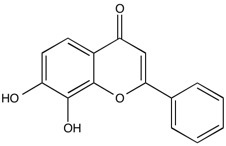7,8-Dihydroxyflavone | TrkB agonist/neurotrophic
NMR (Conforms)

Available Options
| size : | Price | Quantity | |
|---|---|---|---|
| 100 mg | $45.00 | ||
| 500 mg | $150.00 |
7,8-Dihydroxyflavone (38183-03-8) is a selective TrkB agonist (Kd=320 nM) with potent neurotrophic activity.1,2 Significantly improves motor deficits, ameliorates brain atrophy and extends survival in the well-characterized N171-82Q Huntington’s disease mouse model.3 Post-traumatic brain injury-treatment promotes neurogenesis in the hippocampus in a mouse model.4 Improves motor performance and motor neuronal survival in an ALS mouse model.5
References/Citations:
1) Jang et al. (2010), A selective TrkB agonist with potent neurotrophic activities by 7,8-dihydroxyflavone; Proc. Natl. Acad. Sci. USA, 107 2687
2) Liu et al. (2014) Biochemical and biophysical investigation of the brain-derived neurotrophic factor mimetic 7,8-dihydroxyflavone in the binding and activation of the TrkB receptor; J. Biol. Chem., 289 27571
3) Jiang et al. (2013) Small-molecule TrkB receptor agonist improve motor function and extend survival in a mouse model of Huntington’s disease; Hum. Mol. Genet., 22 2462
4) Zhao et al. (2016) Post-injury Treatment of 7,8-Dihydroxyflavone Promotes Neurogenesis in the Hippocampus of the Adult Mouse; J. Neurotrauma, 33 2055
5) Korkmaz et al. (2014) 7,8-dihydroxyflavone improves motor performance and enhances lower motor neuronal survival in a mouse model of amyotrophic lateral sclerosis; Neurosci. Lett., 566 286
NMR (Conforms)
Safety Data Sheet:
Product Data Sheet:
Materials provided by Focus Biomolecules are for laboratory research use only and are not intended for human or veterinary applications. Please note that we do not sell to individuals and that all orders placed by non-research organizations will incur a $20 restocking/refund fee
7,8-Dihydroxyflavone (38183-03-8) is a selective TrkB agonist (Kd=320 nM) with potent neurotrophic activity.1,2 Significantly improves motor deficits, ameliorates brain atrophy and extends survival in the well-characterized N171-82Q Huntington’s disease mouse model.3 Post-traumatic brain injury-treatment promotes neurogenesis in the hippocampus in a mouse model.4 Improves motor performance and motor neuronal survival in an ALS mouse model.5
References/Citations:
1) Jang et al. (2010), A selective TrkB agonist with potent neurotrophic activities by 7,8-dihydroxyflavone; Proc. Natl. Acad. Sci. USA, 107 2687
2) Liu et al. (2014) Biochemical and biophysical investigation of the brain-derived neurotrophic factor mimetic 7,8-dihydroxyflavone in the binding and activation of the TrkB receptor; J. Biol. Chem., 289 27571
3) Jiang et al. (2013) Small-molecule TrkB receptor agonist improve motor function and extend survival in a mouse model of Huntington’s disease; Hum. Mol. Genet., 22 2462
4) Zhao et al. (2016) Post-injury Treatment of 7,8-Dihydroxyflavone Promotes Neurogenesis in the Hippocampus of the Adult Mouse; J. Neurotrauma, 33 2055
5) Korkmaz et al. (2014) 7,8-dihydroxyflavone improves motor performance and enhances lower motor neuronal survival in a mouse model of amyotrophic lateral sclerosis; Neurosci. Lett., 566 286
Calculate the molar concentration, mass or volume in a solution.
Concentration × Volume × Molecular Weight = Mass
Focus Biomolecules • Plymouth Meeting, PA USA • 1-855-FOCUS21
Focus Biomolecules
Plymouth Meeting, PA USA
1-855-FOCUS21
Website Created by Advanta Advertising LLC.

